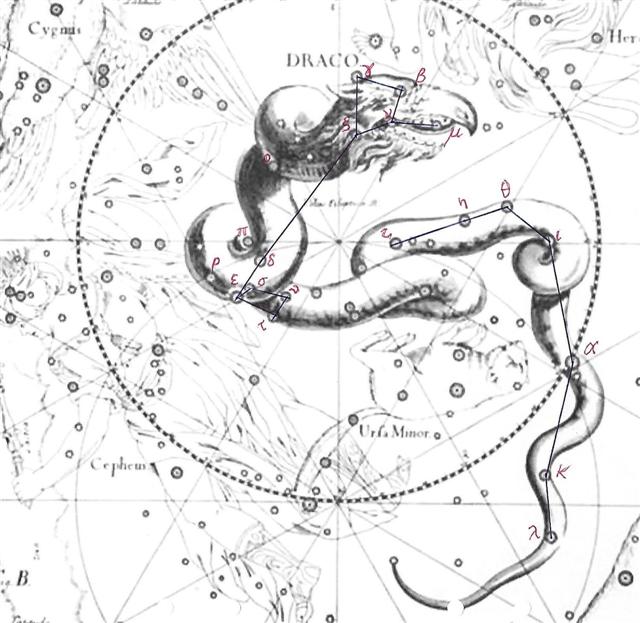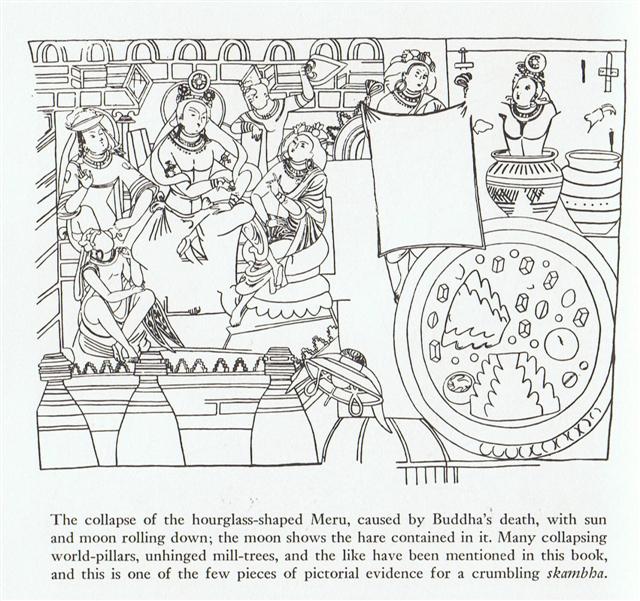We should now put Rogo who has lost his head "σ, 6.5, in the second coil [in Draco] northeast from δ, is Alsafi, corrupted from Athāfi, erroneously transcribed from the Arabic plural Athāfiyy, by which the nomads designated the tripods of their open-air kitchens; one of these being imagined as σ, τ and υ." (Allen)
in its proper place in the overall pattern:
First we ought, however, to consider Alrami (α Sagittarii) at the left illuminated front leg of the Archer Horse - and once again we will clearly perceive the leg pattern 1 + 3.
The Babylonians had here - where the Milky Way River was 'raised up' -
a Cargo Boat waiting:
This vehicle evidently evolved into an overturned king's crown (Corona Australis) we can see in the version of Hevelius and wife.
The meaning is probably about the same. Beyond the end (viz. at the Milky Way Tree) the ruler would be safely transported - ships are always female - across to the other side in order to return again, to be reborn.
The Uranus figure standing on Virgo (in the Roman illustration above) was destined to return again later, this is obvious from comparing him with the little fellow in the front bottom corner (reading withershins). The father does not disappear, he goes on being fulfilled.
Below Alrami (α) is the brighter female double star Arkab (β) "β¹, Double, 3.8 and 8, and β², 4.4. Arkab and Urkab are from Al 'Urkūb, translated by Ideler as the Tendon uniting the calf of the leg to the heel, and this coincides with their location in the figure of the modern maps, as well as with their Euphratean title Ur-ner-gub, the Sole of the Left Foot ..." (Allen) ... And then I happened to stumble on a report regarding the behaviour of chimpanzees, viz. how modern science slowly had begun to understand that they communicated not only vocally but also by signs. For instance, when the mother lifted up her foot so its underside became visible her offspring immediately understood that he should jump onto her back because it was time to move on .... - the Tendon which unites (Haka-taka). ... There is a couple residing in one place named Kui and Fakataka. After the couple stay together for a while Fakataka is pregnant. So they go away because they wish to go to another place - they go. The canoe goes and goes, the wind roars, the sea churns, the canoe sinks. Kui expires while Fakataka swims. Fakataka swims and swims, reaching another land. She goes there and stays on the upraised reef in the freshwater pools on the reef, and there delivers her child, a boy child. She gives him the name Taetagaloa. When the baby is born a golden plover flies over and alights upon the reef. (Kua fanau lā te pepe kae lele mai te tuli oi tū mai i te papa). And so the woman thus names various parts of the child beginning with the name 'the plover' (tuli): neck (tuliulu), elbow (tulilima), knee (tulivae) ...
|
||||||||||||||||||||||||||||||||||||||||||||||||||||||||||||||||||||||||||||||||||||||||||||||||||||||||||||||||||||||||||||||||||||||||||||||||||||
.jpg)












.jpg)





